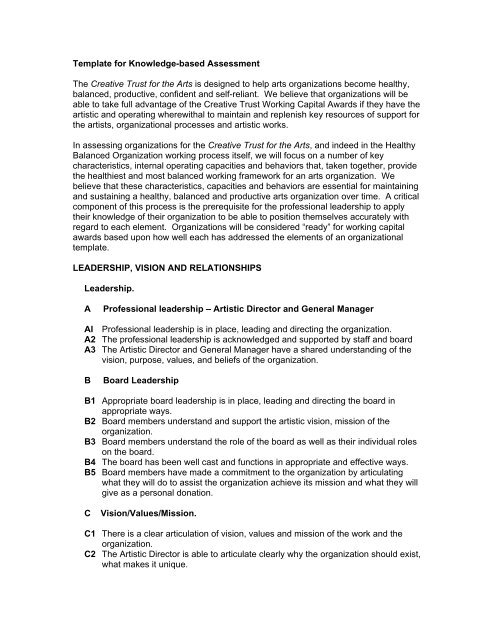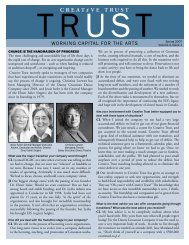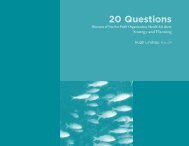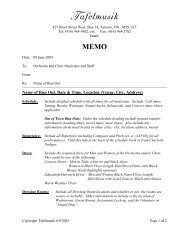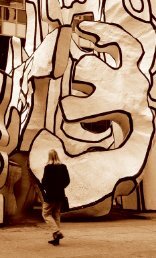Template for Knowledge-based Assessment The Creative Trust for ...
Template for Knowledge-based Assessment The Creative Trust for ...
Template for Knowledge-based Assessment The Creative Trust for ...
Create successful ePaper yourself
Turn your PDF publications into a flip-book with our unique Google optimized e-Paper software.
<strong>Template</strong> <strong>for</strong> <strong>Knowledge</strong>-<strong>based</strong> <strong>Assessment</strong><br />
<strong>The</strong> <strong>Creative</strong> <strong>Trust</strong> <strong>for</strong> the Arts is designed to help arts organizations become healthy,<br />
balanced, productive, confident and self-reliant. We believe that organizations will be<br />
able to take full advantage of the <strong>Creative</strong> <strong>Trust</strong> Working Capital Awards if they have the<br />
artistic and operating wherewithal to maintain and replenish key resources of support <strong>for</strong><br />
the artists, organizational processes and artistic works.<br />
In assessing organizations <strong>for</strong> the <strong>Creative</strong> <strong>Trust</strong> <strong>for</strong> the Arts, and indeed in the Healthy<br />
Balanced Organization working process itself, we will focus on a number of key<br />
characteristics, internal operating capacities and behaviors that, taken together, provide<br />
the healthiest and most balanced working framework <strong>for</strong> an arts organization. We<br />
believe that these characteristics, capacities and behaviors are essential <strong>for</strong> maintaining<br />
and sustaining a healthy, balanced and productive arts organization over time. A critical<br />
component of this process is the prerequisite <strong>for</strong> the professional leadership to apply<br />
their knowledge of their organization to be able to position themselves accurately with<br />
regard to each element. Organizations will be considered “ready” <strong>for</strong> working capital<br />
awards <strong>based</strong> upon how well each has addressed the elements of an organizational<br />
template.<br />
LEADERSHIP, VISION AND RELATIONSHIPS<br />
Leadership.<br />
A<br />
Professional leadership – Artistic Director and General Manager<br />
AI Professional leadership is in place, leading and directing the organization.<br />
A2 <strong>The</strong> professional leadership is acknowledged and supported by staff and board<br />
A3 <strong>The</strong> Artistic Director and General Manager have a shared understanding of the<br />
vision, purpose, values, and beliefs of the organization.<br />
B<br />
Board Leadership<br />
B1 Appropriate board leadership is in place, leading and directing the board in<br />
appropriate ways.<br />
B2 Board members understand and support the artistic vision, mission of the<br />
organization.<br />
B3 Board members understand the role of the board as well as their individual roles<br />
on the board.<br />
B4 <strong>The</strong> board has been well cast and functions in appropriate and effective ways.<br />
B5 Board members have made a commitment to the organization by articulating<br />
what they will do to assist the organization achieve its mission and what they will<br />
give as a personal donation.<br />
C<br />
Vision/Values/Mission.<br />
C1 <strong>The</strong>re is a clear articulation of vision, values and mission of the work and the<br />
organization.<br />
C2 <strong>The</strong> Artistic Director is able to articulate clearly why the organization should exist,<br />
what makes it unique.
C3 <strong>The</strong> Artistic Director is able to clearly describe the philosophic and aesthetic<br />
values that underlie the artistic choices <strong>for</strong> the creation, production and/or<br />
presentation of artistic works.<br />
C4 This in<strong>for</strong>mation is clearly communicated internally and externally.<br />
Relationships.<br />
<strong>The</strong>re is a commitment to developing and maintaining quality relationships, both<br />
internally among the organization’s professional staff and board and externally with<br />
community partners and audiences.<br />
D<br />
D1<br />
D2<br />
D3<br />
E<br />
E1<br />
E2<br />
E3<br />
Internal Relationships:<br />
<strong>The</strong>re is a shared sense of purpose among professional staff along with a<br />
clear understanding of the values and beliefs that in<strong>for</strong>m how everyone<br />
works together.<br />
<strong>The</strong> organization has a distinct working culture that is shared by the<br />
artistic, administrative and board centres.<br />
<strong>The</strong> Artistic Director and General Manager have an excellent working<br />
relationship.<br />
External Relationships:<br />
<strong>The</strong>re is a commitment to developing and maintaining quality<br />
relationships with other arts organizations and key partner organizations<br />
in the community.<br />
<strong>The</strong>re is a commitment to developing and maintaining quality<br />
relationships with the audience and donors and patrons of the<br />
organization.<br />
<strong>The</strong> Board of Directors is well cast from the community and develops and<br />
maintains supportive relationships with key community members.<br />
II WORKING FORMAT, THE ORGANIZATIONAL EQUATION AND<br />
INFRASTRUCTURE<br />
F Working Format<br />
F1 <strong>The</strong> working <strong>for</strong>mat—whether it is project <strong>based</strong> or operational—reflects the<br />
defined and understood processes of collaborating, planning, analyzing needs<br />
and problems, strategizing, problem solving, decision making and taking action.<br />
F2 <strong>The</strong> <strong>for</strong>mat is in<strong>for</strong>med by and consistent with the professional leadership’s<br />
artistic, programming and/or curatorial processes.<br />
G <strong>The</strong> Organizational Equation/Balance<br />
G1 <strong>The</strong>re is a clear understanding of the organizational equation and the critical<br />
balance between programs and activities and available human, financial, time,<br />
material and technical resources.<br />
G2 <strong>The</strong>re is a clear and coherent understanding of the condition of the equation at<br />
any given time.<br />
H Infrastructure<br />
H1 <strong>The</strong>re are organizational structures and systems appropriate and adequate to the<br />
work in place and working effectively.
H2 <strong>The</strong>re are appropriate management, financial and in<strong>for</strong>mation systems in place.<br />
H3 <strong>The</strong>re are appropriate and adequate strategic support systems <strong>for</strong> earned and<br />
contributed income programs in place.<br />
H4 <strong>The</strong>re are appropriate human resources with necessary attributes and skill sets<br />
to maintain a healthy organizational operation and balance.<br />
III<br />
EFFECTIVE PLANNING AND LEARNING PROCESSES<br />
Working Processes<br />
I1 <strong>The</strong>re are clearly described, defined and understood processes <strong>for</strong> collaborating,<br />
analyzing needs and problems, strategizing, solving problems, making decisions<br />
and taking action.<br />
I2 <strong>The</strong> working processes are in<strong>for</strong>med by and consistent with the professional<br />
leadership’s artistic, programming and/or curatorial processes.<br />
Planning and Learning<br />
J1 <strong>The</strong>re is a planning process in place that addresses short, medium and long term<br />
planning concerns and issues.<br />
J2 This process is an effective learning tool that helps the organization adapt to or<br />
effect change within its working conditions or environment.<br />
J3 <strong>The</strong> process defines the quantitative and qualitative indicators that allow the<br />
organization to evaluate its progress and learning.<br />
IV<br />
RESOURCE DEVELOPMENT: RELATIONSHIP TO AUDIENCES AND<br />
CONTRIBUTED INCOME<br />
K Relationship to Audience – Earned Income<br />
K1 <strong>The</strong>re is clarity with regard to whom the organization wants to connect and why.<br />
K2 <strong>The</strong>re is the same commitment to quality relationships internally extended to<br />
relationships with the audience.<br />
K3 <strong>The</strong>re is a commitment and process in place to build and maintain audience<br />
relationships <strong>for</strong> both the short and long term.<br />
K4 <strong>The</strong>re are clear and coherent concepts, plans and approaches <strong>for</strong> generating and<br />
growing earned income that are appropriate to the work, community<br />
environment, organizational values and internal capacities.<br />
L Contributed Income<br />
L1 <strong>The</strong>re are clear and coherent concepts, plans and approaches <strong>for</strong> generating and<br />
growing contributed income that are appropriate to the work, community<br />
environment, organizational values and internal capacities.


